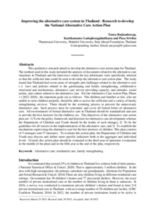Abstracts:
This qualitative research aimed to develop the alternative care action plan for Thailand. The method used in this study included the analysis of documents related to the alternative care situations in Thailand and the interviews where the key informants were specifically selected so that the collected data could be used to develop the alternative care action plan. The study found that Thailand had seven areas of strengths and challenges related to the alternative care i.e. laws and policies related to the gatekeeping and family strengthening, collaborative structured and mechanisms, alternative care service providing capacity, and attitudes, social norms, and culture related to the alternative care. For the Alternative Care Action Plan, Phase 1 (2022-2026), the important goals are as follows: The children and families at risk, who are unable to raise children properly, should be able to access the sufficient and a variety of family strengthening services.
There should be the screening process to prevent the unnecessary alternative care. Such process must be systematic and cover all formal forms of alternative care. All environments of formal alternative care in Thailand should be standardized and aim to provide the best interests for the children, etc. The objectives of the alternative care action plan are:
1) To be the policy framework and direction for alternative care development whereas the Department of Children and Youth should be the leader of such changes;
2) To be the guidelines for all sectors in the implementation of the alternative care; and
3) To establish the mechanism supervising the alternative care for the best interests of children.
This plan consists of 5 strategies and 37 measures. To evaluate this action plan, the Department of Children and Youth may discuss and define more specific indicators both at the aggregate and individual levels. Overall, this action plan should be evaluated in the third year of operation (evaluation in the middle of the plan) and in the fifth year at the end of the plan, respectively.

